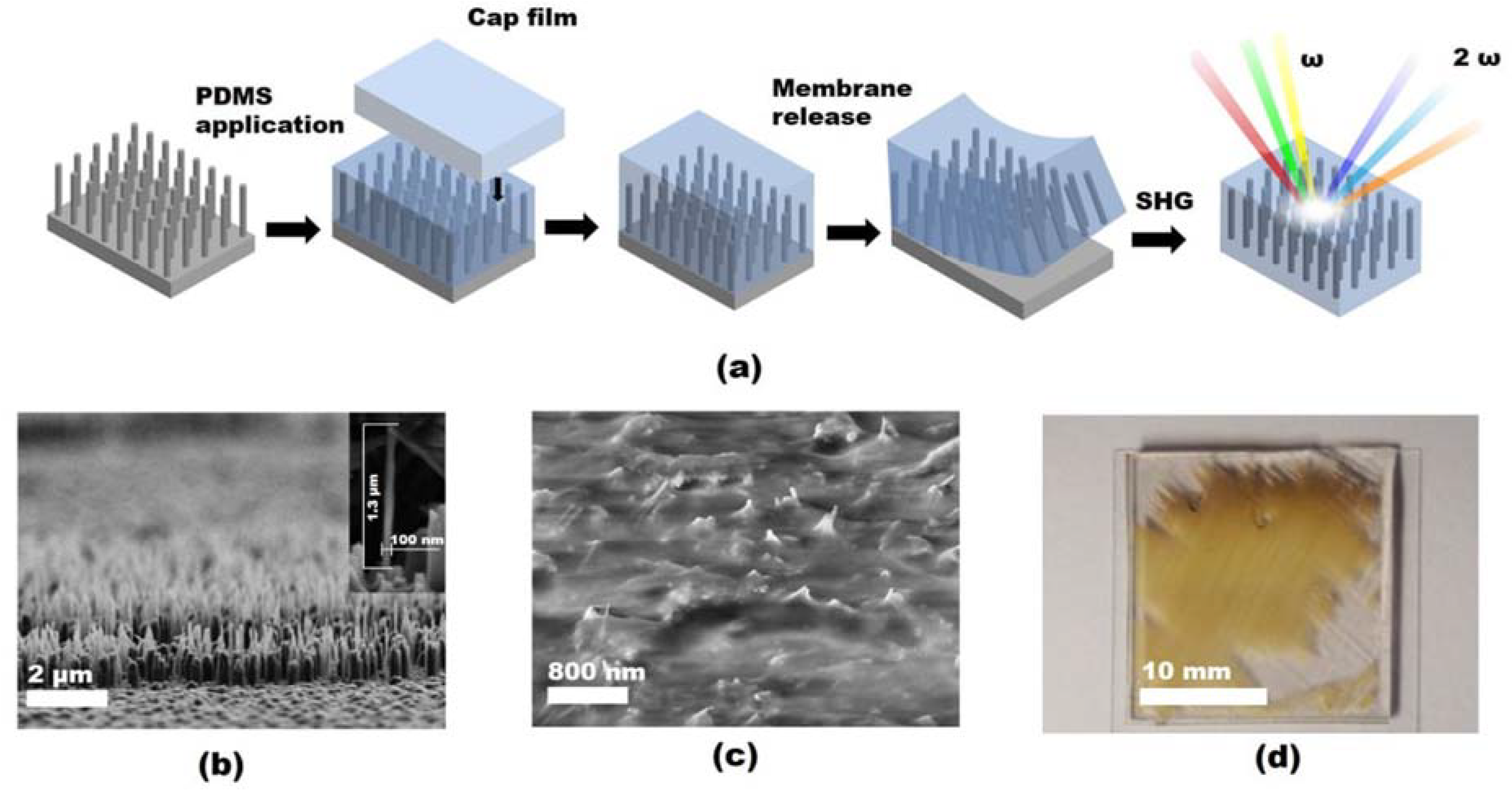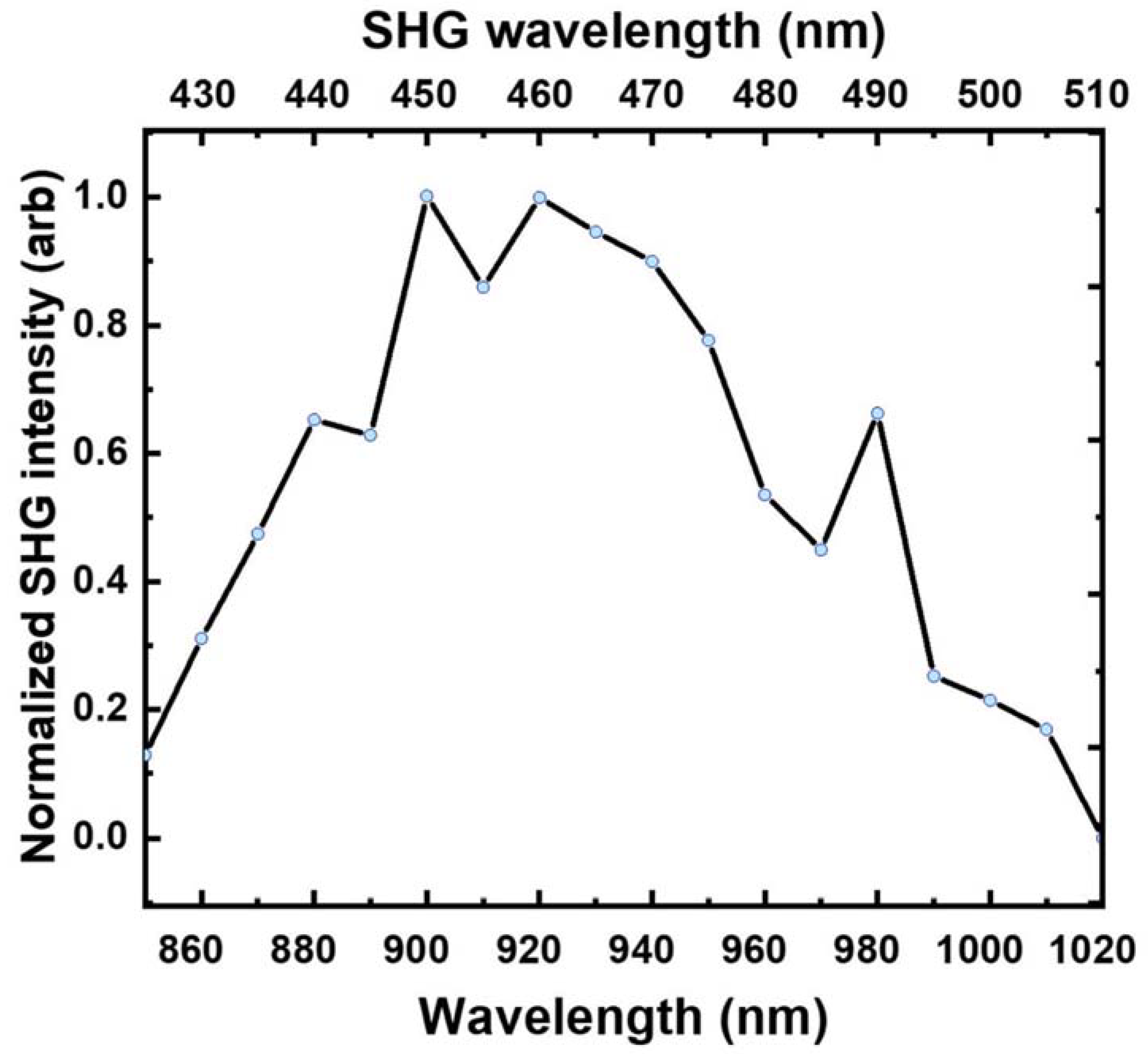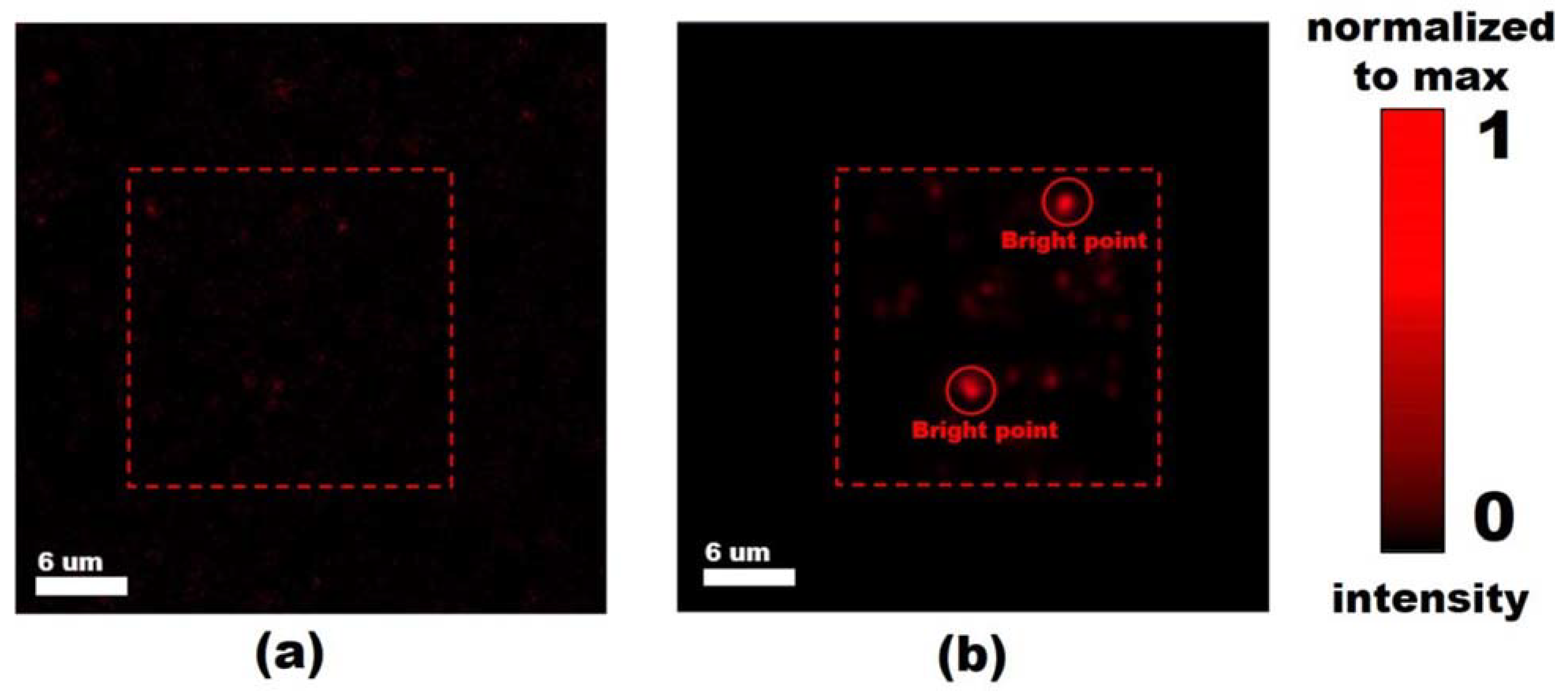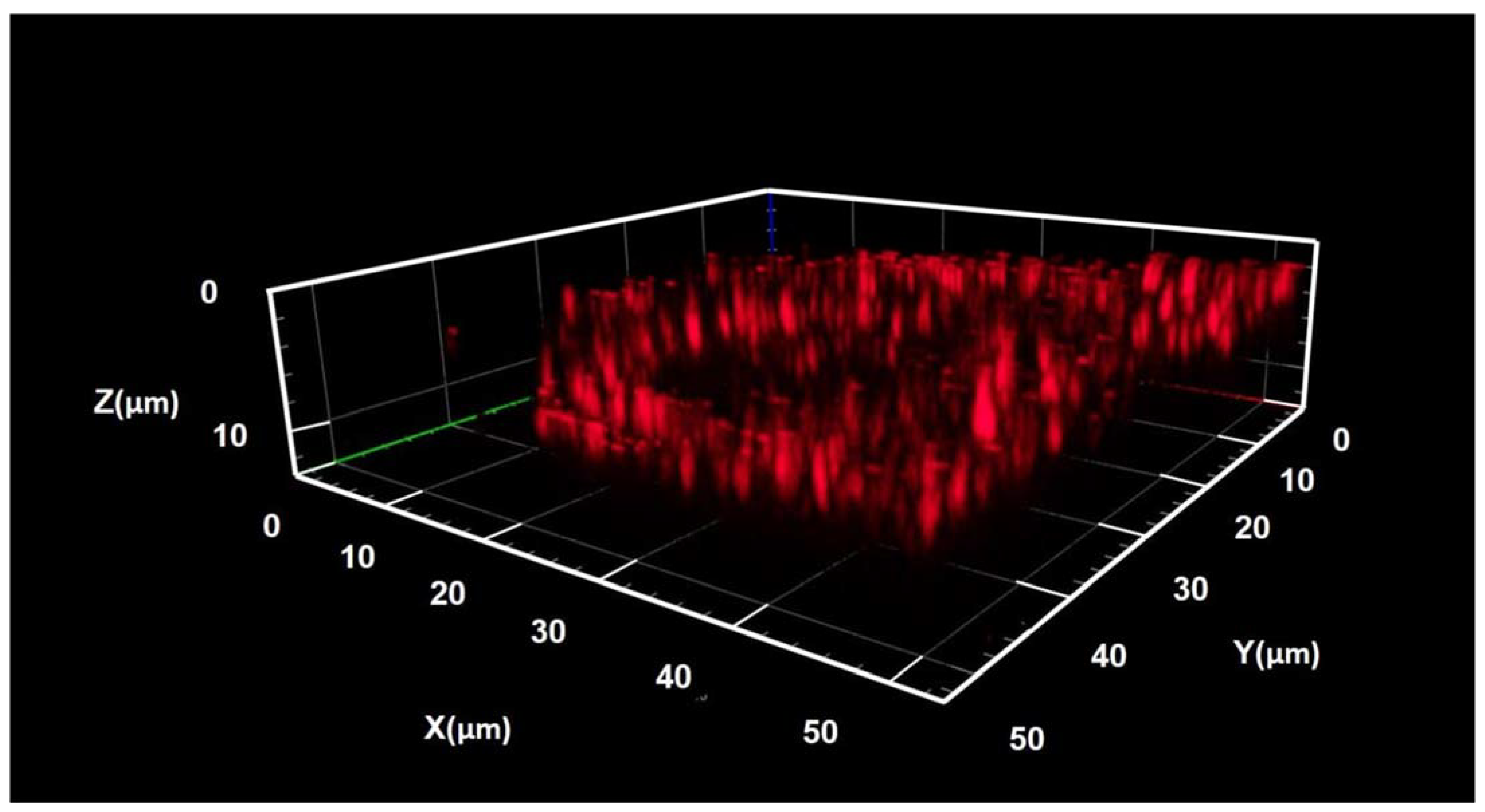Laser-Activated Second Harmonic Generation in Flexible Membrane with Si Nanowires
Abstract
1. Introduction
2. Experimental Section
2.1. Si NWs Fabrication
2.2. Membrane Fabrication
2.3. XRD Experiment
2.4. Second Harmonic Measurements
3. Results and Discussion
4. Conclusions
Author Contributions
Funding
Data Availability Statement
Conflicts of Interest
References
- Schriever, C.; Bianco, F.; Cazzanelli, M.; Ghulinyan, M.; Eisenschmidt, C.; De Boor, J.; Schmid, A.; Heitmann, J.; Pavesi, L.; Schilling, J. Second-Order Optical Nonlinearity in Silicon Waveguides: Inhomogeneous Stress and Interfaces. Adv. Opt. Mater. 2015, 3, 129–136. [Google Scholar] [CrossRef]
- Borghi, M.; Castellan, C.; Signorini, S.; Trenti, A.; Pavesi, L. Nonlinear silicon photonics. J. Opt. 2017, 19, 093002. [Google Scholar]
- Berciano, M.; Marcaud, G.; Damas, P.; Le Roux, X.; Crozat, P.; Ramos, C.A.; Galacho, D.P.; Benedikovic, D.; Marris-Morini, D.; Cassan, E.; et al. Fast linear electro-optic effect in a centrosymmetric semiconductor. Commun. Phys. 2018, 1, 64. [Google Scholar] [CrossRef]
- Bloembergen, N.; Chang, R.K.; Lee, C.H. Second-harmonic generation of light in reflection from media with inversion symmetry. Phys. Rev. Lett. 1966, 16, 986–989. [Google Scholar] [CrossRef]
- Bloembergen, N.; Chang, R.K.; Jha, S.S.; Lee, C.H. Optical second-harmonic generation in reflection from media with inversion symmetry. Phys. Rev. 1968, 174, 813. [Google Scholar] [CrossRef]
- Kikuchi, K.; Tada, K. Theory of electric field-induced optical second harmonic generation in semiconductors. Opt. Quantum Electron. 1980, 12, 199–205. [Google Scholar] [CrossRef]
- Rodríguez-Suné, L.; Scalora, M.; Johnson, A.S.; Cojocaru, C.; Akozbek, N.; Coppens, Z.J.; Perez-Salinas, D.; Wall, S.; Trull, J. Study of second and third harmonic generation from an indium tin oxide nanolayer: Influence of nonlocal effects and hot electrons. Apl Photonics 2020, 5, 010801. [Google Scholar] [CrossRef]
- Nitiss, E.; Hu, J.; Stroganov, A.; Brès, C.S. Optically reconfigurable quasi-phase-matching in silicon nitride microresonators. Nat. Photonics 2022, 16, 134–141. [Google Scholar] [CrossRef]
- Pisarev, R.V.; Kaminski, B.; Lafrentz, M.; Pavlov, V.; Yakovlev, D.; Bayer, M. Novel mechanisms of optical harmonics generation in semiconductors. Phys. Status Solidi 2010, 247, 1498–1504. [Google Scholar] [CrossRef]
- Petukhov, A.V.; Liebsch, A. Isotropic and anisotropic bulk contributions to second-harmonic generation from simple metals. Surf. Sci. 1993, 294, 381–402. [Google Scholar] [CrossRef]
- Han, S.-T.; Peng, H.; Sun, Q.; Venkatesh, S.; Chung, K.-S.; Lau, S.C.; Zhou, Y.; Roy, V.A.L. An overview of the development of flexible sensors. Adv. Mater. 2017, 29, 1700375. [Google Scholar] [CrossRef] [PubMed]
- Fedorov, V.V.; Bolshakov, A.; Sergaeva, O.; Neplokh, V.; Markina, D.; Bruyere, S.; Saerens, G.; Petrov, M.I.; Grange, R.; Timofeeva, M.; et al. Gallium phosphide nanowires in a free-standing, flexible, and semitransparent membrane for large-scale infrared-to-visible light conversion. ACS Nano 2020, 14, 10624–10632. [Google Scholar] [CrossRef] [PubMed]
- Hoeh, M.A.; Neu, J.; Schmitt, K.; Rahm, M. Optical tuning of ultra-thin, silicon-based flexible metamaterial membranes in the terahertz regime. Opt. Mater. Express 2015, 5, 408–415. [Google Scholar] [CrossRef]
- Bhowmik, G.; An, Y.Q.; Schujman, S.; Diebold, A.C.; Huang, M. Optical second harmonic generation from silicon (100) crystals with process tailored surface and embedded silver nanostructures for silicon nonlinear nanophotonics. J. Appl. Phys. 2020, 128, 165106. [Google Scholar] [CrossRef]
- Nikolaeva, A.; Fedorov, V.V.; Gudovskikh, A.S.; Morozov, I.A.; Mastalieva, V.; Neplokh, V.; Mukhin, I.S.; Makarov, S.V. Silicon nanowire/polymer membrane for infrared visualization via third-harmonic generation. J. Phys. Conf. Ser. 2021, 2015, 012096. [Google Scholar] [CrossRef]
- Wiecha, P.R.; Arbouet, A.; Kallel, H.; Periwal, P.; Baron, T.; Paillard, V. Enhanced nonlinear optical response from individual silicon nanowires. Phys. Rev. B—Condens. Matter Mater. Phys. 2015, 91, 121416. [Google Scholar] [CrossRef]
- Iqbal, M.A.; Anwar, N.; Malik, M.; Al-Bahrani, M.; Islam, M.R.; Choi, J.R.; Pham, P.V.; Liu, X. Nanostructures/graphene/silicon junction-based high-performance photodetection systems: Progress, challenges, and future trends. Adv. Mater. Interfaces 2023, 10, 2202208. [Google Scholar] [CrossRef]
- Castellan, C.; Trenti, A.; Vecchi, C.; Marchesini, A.; Mancinelli, M.; Ghulinyan, M.; Pucker, G.; Pavesi, L. On the origin of second harmonic generation in silicon waveguides with silicon nitride cladding. Sci. Rep. 2019, 9, 1088. [Google Scholar] [CrossRef]
- Makarov, S.V.; Petrov, M.I.; Zywietz, U.; Milichko, V.; Zuev, D.; Lopanitsyna, N.; Kuksin, A.; Mukhin, I.; Zograf, G.; Ubyivovk, E.; et al. Efficient second-harmonic generation in nanocrystalline silicon nanoparticles. Nano Lett. 2017, 17, 3047–3053. [Google Scholar] [CrossRef]
- Ng, R.M.Y.; Wang, T.; Liu, F.; Zuo, X.; He, J.; Chan, M. Vertically stacked silicon nanowire transistors fabricated by inductive plasma etching and stress-limited oxidation. IEEE Electron Device Lett. 2009, 30, 520–522. [Google Scholar] [CrossRef]
- Mirza, M.M.; Zhou, H.; Velha, P.; Li, X.; Docherty, K.E.; Samarelli, A.; Ternent, G.; Paul, D.J. Nanofabrication of high aspect ratio (∼50:1) sub-10 nm silicon nanowires using inductively coupled plasma etching. J. Vac. Sci. Technol. B Nanotechnol. Microelectron. Mater. Process. Meas. Phenom. 2012, 30, 06FF02. [Google Scholar] [CrossRef]
- Agati, M.; Amiard, G.; Le Borgne, V.; Castrucci, P.; Dolbec, R.; De Crescenzi, M.; El Khakani, M.A.; Boninelli, S. Growth Mechanisms of Inductively-Coupled Plasma Torch Synthesized Silicon Nanowires and their associated photoluminescence properties. Sci. Rep. 2016, 6, 37598. [Google Scholar] [CrossRef] [PubMed]
- Dussart, R.; Boufnichel, M.; Marcos, G.; Lefaucheux, P.; Basillais, A.; Benoit, R.; Tillocher, T.; Mellhaoui, X.; Estrade-Szwarckopf, H.; Ranson, P. Passivation mechanisms in cryogenic SF6/O2 etching process. J. Micromech. Microeng. 2003, 14, 190. [Google Scholar] [CrossRef]
- Kochetkov, F.M.; Neplokh, V.; Fedorov, V.V.; Bolshakov, A.D.; A Sharov, V.; E Eliseev, I.; Tchernycheva, M.; E Cirlin, G.; Nasibulin, A.G.; Islamova, R.M.; et al. Fabrication and electrical study of large area free-standing membrane with embedded GaP NWs for flexible devices. Nanotechnology 2020, 31, 46LT01. [Google Scholar] [CrossRef]
- Nikolaeva, A.; Mastalieva, V.; Gudovskikh, A.S.; Morozov, I.A.; Fedorov, V.V.; Petrov, M.; Neplokh, V.; Mukhin, I.S.; Makarov, S.V. Large-scale flexible membrane with resonant silicon nanowires for infrared visualization via efficient third harmonic generation. Appl. Phys. Lett. 2022, 120, 151102. [Google Scholar] [CrossRef]
- Neplokh, V.; Kochetkov, F.M.; Deriabin, K.V.; Fedorov, V.V.; Bolshakov, A.D.; Eliseev, I.E.; Mikhailovskii, V.Y.; Ilatovskii, D.A.; Krasnikov, D.V.; Tchernycheva, M.; et al. Modified silicone rubber for fabrication and contacting of flexible suspended membranes of n-/p-GaP nanowires with a single-walled carbon nanotube transparent contact. J. Mater. Chem. C 2020, 8, 3764–3772. [Google Scholar] [CrossRef]
- Nasibulin, A.G.; Ollikainen, A.; Anisimov, A.S.; Brown, D.P.; Pikhitsa, P.V.; Holopainen, S.; Penttilä, J.S.; Helistö, P.; Ruokolainen, J.; Choi, M.; et al. Integration of single-walled carbon nanotubes into polymer films by thermo-compression. Chem. Eng. J. 2008, 136, 409–413. [Google Scholar] [CrossRef]
- Suturin, S.M.; Fedorov, V.V.; Korovin, A.M.; Sokolov, N.S.; Nashchekin, A.V.; Tabuchi, M. Epitaxial Ni nanoparticles on CaF2 (001),(110) and (111) surfaces studied by three-dimensional RHEED, GIXD and GISAXS reciprocal-space mapping techniques. J. Appl. Crystallogr. 2017, 50, 830–839. [Google Scholar] [CrossRef]
- Du, Y.; Liu, S.; Yuan, S.; Zhang, H.; Yuan, S. A study of influence factors to improve the heat transfer of pure-polydimethylsiloxane (PDMS): A molecular dynamics study. Colloids Surf. A Physicochem. Eng. Asp. 2021, 618, 126409. [Google Scholar] [CrossRef]
- Bonse, J.; Brzezinka, K.W.; Meixner, A.J. Modifying single-crystalline silicon by femtosecond laser pulses: An analysis by micro Raman spectroscopy, scanning laser microscopy and atomic force microscopy. Appl. Surf. Sci. 2004, 221, 215–230. [Google Scholar] [CrossRef]
- Hoh, K.; Koyama, H.; Uda, K.; Miura, Y. Incorporation of oxygen into silicon during pulsed-laser irradiation. Jpn. J. Appl. Phys. 1980, 19, L375. [Google Scholar] [CrossRef]
- Fomenko, V.; Lami, J.; Borguet, E. Nonquadratic second-harmonic generation from semiconductor-oxide interfaces. Phys. Rev. B 2001, 63, 121316. [Google Scholar] [CrossRef]
- Zhang, B.; Stehr, J.E.; Chen, P.P.; Wang, X.; Ishikawa, F.; Chen, W.M.; Buyanova, I.A. Anomalously Strong Second-Harmonic Generation in GaAs Nanowires via Crystal-Structure Engineering. Adv. Funct. Mater. 2021, 31, 2104671. [Google Scholar] [CrossRef]
- Alekseev, P.A.; Dunaevskiy, M.S.; Kirilenko, D.A.; Smirnov, A.N.; Davydov, V.Y.; Berkovits, V.L. Observing visible-range photoluminescence in GaAs nanowires modified by laser irradiation. J. Appl. Phys. 2017, 121, 074302. [Google Scholar] [CrossRef]
- Alekseev, P.A.; Smirnov, A.N.; Davydov, V.Y.; Haggrén, T.; Lipsanen, H.; Dunaevskiy, M.S.; Berkovits, V.L. Photodegradation of surface passivated GaAs nanowires. J. Phys. Conf. Ser. 2020, 1461, 012002. [Google Scholar] [CrossRef]






Disclaimer/Publisher’s Note: The statements, opinions and data contained in all publications are solely those of the individual author(s) and contributor(s) and not of MDPI and/or the editor(s). MDPI and/or the editor(s) disclaim responsibility for any injury to people or property resulting from any ideas, methods, instructions or products referred to in the content. |
© 2023 by the authors. Licensee MDPI, Basel, Switzerland. This article is an open access article distributed under the terms and conditions of the Creative Commons Attribution (CC BY) license (https://creativecommons.org/licenses/by/4.0/).
Share and Cite
Mastalieva, V.; Neplokh, V.; Aybush, A.; Fedorov, V.; Yakubova, A.; Koval, O.; Gudovskikh, A.; Makarov, S.; Mukhin, I. Laser-Activated Second Harmonic Generation in Flexible Membrane with Si Nanowires. Nanomaterials 2023, 13, 1563. https://doi.org/10.3390/nano13091563
Mastalieva V, Neplokh V, Aybush A, Fedorov V, Yakubova A, Koval O, Gudovskikh A, Makarov S, Mukhin I. Laser-Activated Second Harmonic Generation in Flexible Membrane with Si Nanowires. Nanomaterials. 2023; 13(9):1563. https://doi.org/10.3390/nano13091563
Chicago/Turabian StyleMastalieva, Viktoriia, Vladimir Neplokh, Arseniy Aybush, Vladimir Fedorov, Anastasiya Yakubova, Olga Koval, Alexander Gudovskikh, Sergey Makarov, and Ivan Mukhin. 2023. "Laser-Activated Second Harmonic Generation in Flexible Membrane with Si Nanowires" Nanomaterials 13, no. 9: 1563. https://doi.org/10.3390/nano13091563
APA StyleMastalieva, V., Neplokh, V., Aybush, A., Fedorov, V., Yakubova, A., Koval, O., Gudovskikh, A., Makarov, S., & Mukhin, I. (2023). Laser-Activated Second Harmonic Generation in Flexible Membrane with Si Nanowires. Nanomaterials, 13(9), 1563. https://doi.org/10.3390/nano13091563








